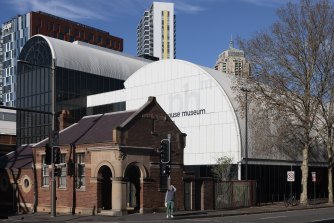
Design guidelines for the Parramatta headquarters placed importance on the riverside site and civic link and did not specify retention of the historic home of Willow Grove, which was subsequently dismantled.
At Ultimo, it is proposed that the museum’s front door is switched from Harris Street to the Goods Line, fronting the light rail line and Chinatown, with a public square to invite visitors inside.
Maximum building heights are to be lifted well above existing planning consents, and the existing roofline along the museum’s Harris Street boundary extended above the museum’s empty forecourt.
Reference architectural plans prepared by John Wardle Architects show a six- to seven-storey addition to the museum, with presentation spaces, a loading dock and two basement floors, tall enough to cause overshadowing.
A separate conservation management plan protects the Ultimo Power House and former Ultimo Post Office buildings, which are both listed on the NSW State Heritage Register and reminders of Sydney’s rich industrial past. It ranks the newer Wran building extension, with its arched steel roof and glazed facades, as having only moderate significance.
It states unsympathetic changes had diminished the original architectural intent to the extent that it no longer represented the original flow and design of the building. The extension turned its back on the old post office, disconnecting it from the heritage core, and offered no public interaction with Harris Street.
Redevelopment provided opportunities for these changes to be removed and the building’s original fabric and form reinstated, the assessment said.

The Post Office building stands at the rear of the Wran Building.Credit:Brook Mitchell
Successful renewals of historic buildings are cited for inspiration including the conversion of the Bankside Power Station into Tate Modern.
The documents say a revitalised Powerhouse Ultimo would add presentation spaces, improve visual connection between the buildings, and increase visitation and public access.
Asked if proposed design guidelines allow for demolition of any buildings, a spokesperson for Create NSW, the government’s arts agency, said the Environmental Impact Statement and design guidelines sought approval for a maximum building envelope that would inform the national design competition.
This scoping would establish development controls for the site and be subject to a future development application with opportunity for public input.
Loading
Following the design competition, the detailed design, construction and operation of buildings and public domain spaces would be separately assessed.
A cultural guide to going out and loving your city. Sign up to our Culture Fix newsletter here.









 Add Category
Add Category